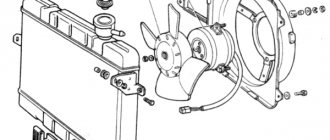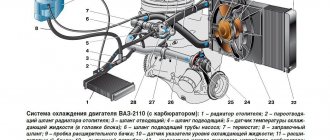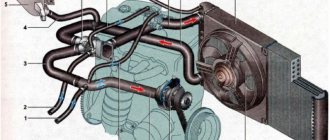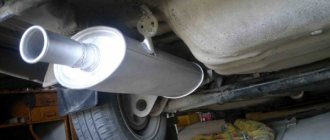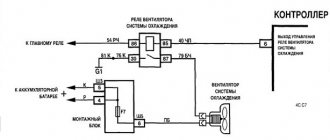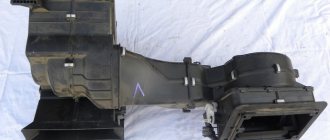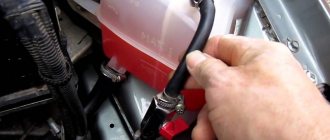Print this article Font size 16
The VAZ 2114 uses a hidden cooling system, which operates on the basis of a special liquid. A mechanical pump ensures that this coolant moves through the system.
Alas, the build quality of the VAZ 2114 radiator and the cooling system as a whole leaves much to be desired, which is why it can fail over time. The main disadvantage of the OS (cooling system) of the “fourteenth” model is the need for constant monitoring, regular maintenance and repair.
The solution to these issues is complicated by the fact that the cooling system of the injection engine on the VAZ 2114 is quite complex and includes 28 elements. The most convenient way to get to know them is on a special chart.
How the OS works
The cooling system of the VAZ 2114 operates on the basis of internal heat exchange, which is carried out under the influence of coolant. It moves forcibly thanks to a pump, which is activated by a drive belt. The mixture enters the OS through the expansion tank.
The electric fan is located on the electric motor shaft. Depending on the indicators of the sensor, it is turned on or off. One of the main elements of the OS is a thermostat valve with a storage tank , which senses changes in air temperature.
If the fluid temperature is around 87 degrees, the main valve turns on and sends fluid through the large circuit. At a temperature of 102 degrees, the valve stops at 8 mm.
DIAGRAM AND DEVICE OF THE COOLING SYSTEM
The cooling system of the VAZ 2114 is liquid, with forced circulation. Antifreeze or antifreeze is poured into the system as a coolant. In the most extreme case, you can fill it with water, but you can’t drive it for a long time - in winter you can defrost the engine, and during the rest of the season, when the engine is used for a long time on water, the cooling jacket in the block and cylinder head is corroded, and rust accumulates in the radiator.
The VAZ 2114 engine cooling system (SOD) consists of the following elements:
- Radiator. It is the main cooling part in the system and performs the function of transferring heat to the liquid into the surrounding airspace;
- Water pump (pump). The pump creates forced movement of antifreeze in the system, thereby cooling the entire SOD, including the internal combustion engine (ICE). The pump rotates from the timing belt;
- Branch pipes (hoses). Antifreeze circulates through them;
- Thermostat. It regulates the passage of coolant through all pipes or only in a small circle and maintains the required operating temperature of the internal combustion engine;
- Electric fan. The fan is located on the plane of the radiator and, due to the air flow created, cools its surface when turned on. The electric motor turns on only when the temperature set by the sensor is reached (103°C);
- Expansion tank. Liquid is poured into the tank, and when the fan is activated, antifreeze flows into it through the return hose, thereby releasing excess pressure into the SOD;
- Expansion tank plugs. There are valves in the plug that relieve excess air pressure created in the system when antifreeze circulates.
The VAZ 2114 cooling diagram is shown in the figure below:
Cooling diagram for VAZ-2114
The design of the engine cooling system on the VAZ model 2114 is simple and practically no different from the design of any other fuel-injected internal combustion engine of a passenger car. After starting the engine, the water pump is driven by the rotating crankshaft through the timing belt. The pump creates coolant circulation in the system, and the antifreeze passes through a small circle (pump, upper pipe, cylinder block). When the internal combustion engine is heated to operating temperature, the thermostat valve opens and the coolant flows through the lower pipe into the internal combustion engine in a large circle.
RADIATOR
The VAZ radiator is aluminum, consists of a double-row core and two plastic tanks on the sides. Coolant is poured into it through the expansion tank; there is a drain plug at the bottom.
PIPE
The set of cooling system pipes includes:
- Upper and lower pipes (main);
- Metal tube of water pump;
- Filler hose from the expansion tank to the radiator;
- Return hose from tank to radiator;
- Two hoses for heating the throttle valve.
Check the integrity of the pipes (very often they sell defective ones in car dealerships)
Replacing the coolant
To normalize the cooling system on a VAZ 2114, sometimes it is enough to replace the coolant. To determine when this needs to be done, you should know some nuances:
- The effective life of antifreeze is 2 years, and antifreeze is 5 years;
- Typically, replacing antifreeze is required after a mileage of 20-40 thousand kilometers, depending on operating conditions;
- A changed color of the composition indicates that it needs to be replaced.
antifreeze as a liquid , since it has a long service life and does not wear out the system so intensively. in favor of antifreeze is its affordable price.
Before adding new fluid, the system should be flushed. For this:
- Drain all existing coolant from the system;
- Screw the plugs tightly;
- Fill with high-quality distilled water to the maximum;
- Start the engine and bring it to operating temperature;
- The revolutions should be about 3 thousand. Avoid overheating the engine;
- After turning off the engine, leave the car for 7 minutes, after which the water is drained. If the system is heavily contaminated, the procedure must be repeated until completely clean distillate begins to pour out.
What is a radiator and what is its function?
The radiator looks like a rectangular box made of numerous and very thin slats. Inside, it is a system through which the coolant passes and is cooled by the oncoming air flow. At the end sides of this element there are two pipes to which water cooling hoses are connected.
The principle of its operation is very simple. When the driver starts the car, the engine begins to work, but the harder and longer it does useful work, the higher its temperature. It's no secret that the fuel-air mixture ignites in the upper part of the cylinder blocks of the power unit. Around this zone there are channels through which coolant flows. The water pump accelerates it under pressure and it enters the “hot” zone. Having made a circle and absorbed the heat, it returns to the radiator. And since it is open to air flow, it cools the liquid, which then repeats its cycle many times.
Why the OS does not work
The cooling system most often stops working due to improper operation of the thermostat. You can't do anything other than replace it.
If you don’t know which cooling radiator is best to choose for the VAZ 2114, look at the existing one. Buy an analogue from the manufacturer, or purchase a device with the closest characteristics.
The fourteenth model is equipped with an aluminum radiator with two additional tanks. The radiator design includes:
- Radiator;
- Upper tank with pipes;
- Bottom tank with pipes.
Radiator selection
The most popular radiators are aluminum, and this is not surprising, because they cost much less than copper (or brass), and they are much easier to find on sale. Based on the type of cooling grille, they can all be divided into two large groups: prefabricated (inside of which there are sets of plates with tubes fixed in them through which coolant circulates) and non-prefabricated (a special corrugated tape is installed inside them).
Aluminum
At the same time, all aluminum radiators (which include the DAAZ heater radiator for the VAZ 2114) have both significant advantages and certain disadvantages.
The first include:
- low cost, especially for prefabricated models;
- high thermal conductivity, ensuring rapid heating;
- light weight;
- high structural rigidity, making them quite resistant to external influences.
Aluminum radiator Daaz
As negative points it is worth noting:
- rapid cooling (again due to high thermal conductivity) - when the engine is turned off, the car cools down quickly;
- short service life (compared to copper models);
- low maintainability (soldering aluminum in garage conditions is extremely difficult).
It is also very important to note that it is impossible to use ordinary water as a coolant (as domestic motorists sometimes do) with an aluminum radiator installed, since it will quickly cause corrosion.
Copper
Speaking about copper radiators, it is worth saying that according to the principle of their design, they are close to aluminum non-assembled radiators, but at the same time they have much better heat transfer.
Their advantages include:
- better heat retention, slow cooling;
- greater efficiency due to higher heat transfer;
- high maintainability (copper can be soldered even in “field” conditions);
- long service life.
Copper radiator VAZ 2114
But, despite such important advantages, they also have the following serious disadvantages:
- high cost (in most cases it is twice the cost of aluminum models);
- very long heating (after turning on the stove, the interior will not warm up soon);
- low efficiency when the engine operates at low speeds.
It is because of these shortcomings that copper radiator models are considered obsolete from a moral point of view, and increasingly even large manufacturers are installing aluminum devices on their cars.
That is why, if you are faced with the problem of choosing whether to take a radiator made of copper or aluminum, it is better to give preference to the latter option. At the same time, not only the material itself is important, but also the overall quality of workmanship.
Radiator replacement
If there is a need to replace the radiator, remember the first golden rule - the engine must be cold before dismantling the device. Therefore, if you just arrived at the garage, let the car sit for a couple of hours. Better yet, leave the car and come back tomorrow.
The replacement procedure itself is as follows.
- Unscrew the plug from the expansion tank and the cylinder and radiator plugs.
- Drain the coolant into a large container.
- Disconnect the radiator ventilation system from the battery.
- Remove the silicone pipes of the VAZ 2114 cooling system by disconnecting them from the radiator and tank.
- Remove the mounting bolts from the casing.
- Hold the radiator and remove the skin and fan together.
- This will completely free the radiator, so you can easily replace it with a new one.
- Assembly of the unit is carried out in reverse order. After replacing the radiator, start the engine and check the efficiency of the new unit.
Order of Operations
If the car has a low seating position or the coolant drain tank is large, work should begin by lifting the car with a jack. The radiator is installed on the TV along with fog and regular headlights. Work should only begin with a cold engine. If the engine is hot, be sure to wait until it cools down.
On a note! Mandatory conditions for performing operations are strict adherence to the sequence and extreme accuracy. Because the engine cooling system is one of the main ones in a vehicle. In parallel with the replacement, it is advisable to revise it and make sure that other components are in good working order and are working properly. Now you can get started:
- After removing the plug from the expansion barrel, the working fluid is drained into a container. It is necessary to drain all the antifreeze that is in the cooling system.
- Now you need to dismantle the filter.
- The radiator must be removed together with the electric fan. To do this, you need to disconnect the power supply to the cooler. Now you need to unscrew the pressure plate and remove it.
- Now you need to remove the inlet and outlet hoses from the pipes. To do this, loosen the fastener clamp.
- The radiator with fan is tilted towards the engine and removed. Attention! Before pulling out the fan, you need to disconnect the wires. They are usually located at the bottom of the device. This is necessary in order to maintain the functionality of the wiring.
- Now you need to disconnect the fan from the radiator. To do this, use a 10mm wrench to unscrew 2 nuts. The fan must be removed along with the casing.
- Installation of the radiator is carried out in the reverse order to that described above. It begins with switching the new node and the fan. Important! Before replacing, make sure that there are 2 rubber cushions. If they are missing, install new ones in the crossmember holes. If they are in place, then the installation of the new unit is carried out on them. The main causes of radiator malfunction
The most common reasons for radiator failure on VAZ 2113, 2114, 2115 are:
- mechanical shocks, for example, stones bouncing off the wheels of passing vehicles;
- pockets of corrosion and contamination inside the tubes;
- damage in an accident.
Radiator repair
In some cases, the radiator can be repaired, so you don’t have to buy a new spare part.
Mostly repair work consists of eliminating leaks that have arisen as a result of defects, cracks and holes.
Most often, liquid leaks at the junction of plastic and metal parts. If there is a small leak, you can pour a special liquid with a coolant mixture inside the radiator. Thanks to its special composition, this product will seal the defects that caused the leak. If the damage is serious, repairs will no longer save the situation; you will still have to replace the radiator.
To check the tightness of the radiator, you can conduct a simple experiment at home.
- Fill the bathroom with enough water to submerge the radiator.
- Close all pipe openings tightly.
- Lower the radiator under water about 30-50 centimeters. Apply a pressure of 0.2 MPa to it.
- Watch what happens. If bubbles appear, the system is not sealed and needs to be repaired or replaced.
Do not even try to repair the radiator after side or frontal impacts in an accident. In such situations, he suffers first of all, and no clogging liquids will help you.
Required spare parts
First of all, you need to select a new radiator. It is better to purchase an analogue of what is on your car. You can also make a choice by article number: 2108-1301012, 21082-1301012, RO2108-01, LRc 01082.
The average price of a new unit is 1,750 rubles. Copper models will cost more.
Attention ! It is better not to purchase painted radiators, since there is a risk of an unpleasant odor appearing in the interior, and the heat transfer of these models is lower.
Conclusion
Today, aluminum radiators are much more popular than copper radiators. The reason for its popularity is that finding a high-quality copper radiator has recently become too difficult.
Another problem is that many models of copper radiators cost exorbitant amounts of money. Not every VAZ 2114 owner can afford to purchase such a unit. An aluminum radiator can cost almost 2 times less!
If we add to this the cost of replacing radiators at a service center, then in the end the car enthusiast’s wallet will become noticeably lighter. Not everyone will be able to replace this unit on their own, so it is worthwhile to include in the budget for replacing the radiator in advance the cost of specialist work.
Aluminum or Copper
Obvious advantages of an aluminum radiator:
- the presence of side ribs is much larger than that of a competitor
- the width of the channels for air flow is greater (this fact can significantly reduce the risk of breakage, and also increases the efficiency of heat supply at idle)
The obvious disadvantage of an aluminum radiator:
- heats up very quickly and cools down just as quickly (heat transfer is 209.3 W/m.deg)
- As soon as a leak is discovered, it needs to be replaced; such a unit cannot be resuscitated
Obvious advantages of a copper heater:
- heats up for a long time and cools down just as long (rather, the second part of the radiator’s property is a plus), heat transfer is 389.6 W/m.deg
- can be reanimated: as soon as a leak appears, you just need to solder the hole
Obvious disadvantages of a copper heater:
- fewer ribs than the competitor
- the channels are small and narrow, they tend to clog quickly, which impairs warming up and adds more reasons for repairs
- At idle it barely warms up.
- it is difficult to find a high-quality copper heater, since almost everyone who makes units from such material uses impurities and can paint the original material, which naturally reduces the heat transfer property
Today, aluminum radiators are clearly more popular than copper ones. And this is primarily due to the difficulty of finding a high-quality copper unit. And if luck smiles on you, then the price for a copper radiator of a VAZ 2114 stove will be many times higher than for an aluminum radiator. Average. You will get aluminum from 1000 rubles, and copper from 1700 rubles! This is still good, if you install it yourself, the radiator replacement service will cost 800-1000 rubles, on average. By the way, if you can’t solder a leaking copper heater on your own, then taking it to the service center every time will be very expensive; you’ll be able to save up for a limousine. And since all VAZ spare parts tend to be imperfect, keep in mind that you will have to deal with this one way or another. So think about whether it’s worth buying a copper radiator for the VAZ 2114 stove.
Let's summarize
In general, repairs are quite accessible for doing it yourself, but you need to immediately prepare for a significant time investment. Work can last for 2-6 hours. When replacing the radiator, it is necessary to change the coolant. Work with 8-valve and 16-valve engines is carried out in the same way. If the car has air conditioning, you will have to remove and install it during the repair, but not on all models. It is advisable to replace the bushings at the same time. The work is completed by checking the functionality of the engine and the condition of the coolant. Namely, whether it is boiling.
For greater clarity on replacing the VAZ 2115 injector cooling radiator, you can watch this video:



